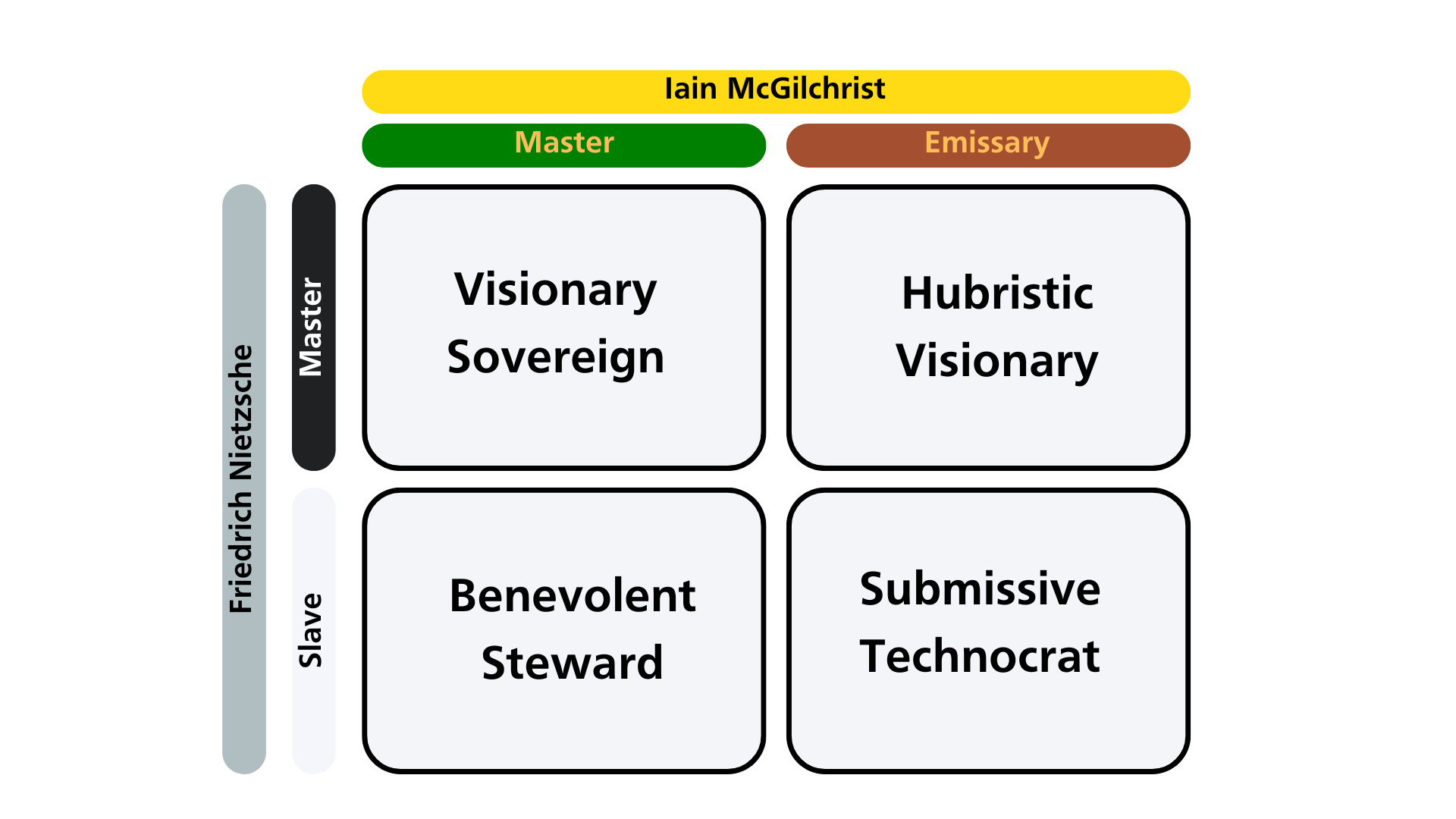Exploring Nietzsche’s Master/Slave Morality and McGilchrist’s Master/Emissary Dynamics
Introduction: Leadership and Sustainability
The challenges of sustainability require more than technological fixes—they demand a fundamental reevaluation of leadership itself. Leadership is not just about action but also about vision, values, and the capacity to balance competing demands in complex systems. Two philosophical frameworks—Nietzsche’s Master/Slave morality and McGilchrist’s Master/Emissary dynamics—offer profound insights into leadership styles and their impact on sustainability.
By synthesizing these frameworks into a 2×2 grid, we can uncover four archetypes of leadership and explore their implications for sustainability. This analysis reveals how certain combinations of leadership styles can either sustain or undermine the conditions for human flourishing and planetary resilience.
Nietzsche’s Master/Slave Morality
Friedrich Nietzsche’s philosophy divides human moralities into two broad categories:
- Master Morality: Rooted in strength, confidence, and the creation of values. Masters assert their will and take responsibility for shaping their world.
- Slave Morality: Reactive, focusing on external forces and constraints. Slaves conform to pre-existing rules and seek security over innovation.
In leadership, Master morality represents vision, assertiveness, and a sense of purpose. Slave morality, while less assertive, emphasizes collaboration and adaptation, which can also be critical in complex systems.
McGilchrist’s Master/Emissary Dynamics
Iain McGilchrist’s The Master and His Emissary explores how the brain’s hemispheres shape perception and decision-making:
- The Master: Holistic, intuitive, and empathetic. The Master sees the bigger picture and values interconnectedness.
- The Emissary: Analytical, detail-oriented, and focused on control. While essential for executing tasks, the Emissary struggles when detached from the Master’s broader guidance.
In leadership, the Master represents systems thinking and ethical responsibility, while the Emissary represents technical proficiency and operational efficiency.
The 2×2 Grid of Leadership Styles
By combining Nietzsche’s moralities with McGilchrist’s dynamics, we can create a 2×2 framework of leadership styles:

Leadership Styles and Sustainability
Each leadership archetype interacts with sustainability differently:
1. Visionary Sovereign (Master dominates, Master morality)
This leader combines McGilchrist’s holistic wisdom with Nietzsche’s assertive value creation. They prioritize long-term ecological balance while crafting bold strategies to navigate complex systems.
- Impact on Sustainability: Proactively builds resilient systems, balancing growth with planetary health.
- Example: Nelson Mandela’s integration of justice, empathy, and vision.
2. Hubristic Visionary (Emissary dominates, Master morality)
This leader relies heavily on rationality and systems but loses touch with holistic, ethical considerations. Their overconfidence leads to decisions that often prioritize short-term gains over sustainability.
- Impact on Sustainability: Unsustainable growth, ecological overshoot, and systemic inequities.
- Example: Napoleon Bonaparte’s brilliance overshadowed by hubris.
3. Benevolent Steward (Master dominates, Slave morality)
This leader focuses on service and collaboration, guided by a deep sense of responsibility. While ethical, they often lack the assertiveness to take decisive action when bold leadership is needed.
- Impact on Sustainability: Maintains harmony but may struggle with large-scale systemic changes.
- Example: Mahatma Gandhi’s selfless leadership.
4. Submissive Technocrat (Emissary dominates, Slave morality)
This leader adheres rigidly to procedures and external authority, prioritizing operational control over creativity or ethical vision.
- Impact on Sustainability: Reinforces the status quo, often perpetuating unsustainable practices.
- Example: Neville Chamberlain’s appeasement policies.
Interactions Between Styles: Synergy or Sabotage?
Leadership styles rarely operate in isolation. Their interactions can amplify or undermine sustainability efforts.
Visionary Sovereign Governing Benevolent Steward
When the Visionary Sovereign provides strategic direction to the Benevolent Steward, the result is an ideal balance of bold vision and ethical collaboration. This synergy fosters sustainable innovation while maintaining ecological integrity.
- Outcome: Flourishing systems where individual and planetary well-being align.
Hubristic Visionary Governing Submissive Technocrat
When the Hubristic Visionary dominates the Submissive Technocrat, the focus shifts to unchecked growth and control. This dynamic accelerates ecological degradation and social inequity, as neither leader prioritizes the broader context.
- Outcome: Unsustainable systems that collapse under their own weight.
Sustainable Leadership: The Need for Balance
True sustainability requires leadership styles that integrate the strengths of all quadrants:
- The Visionary Sovereign’s strategic foresight.
- The Benevolent Steward’s ethical grounding.
- The Hubristic Visionary’s drive for innovation (tempered by humility).
- The Submissive Technocrat’s procedural rigor (guided by holistic vision).
This balance aligns human activity with planetary boundaries, ensuring that leadership fosters flourishing for all life.
Conclusion: A Call to Action
The philosophy of sustainable leadership reminds us that the future depends on the choices we make today. By understanding the dynamics of leadership through Nietzsche’s and McGilchrist’s lenses, we can cultivate leaders who balance vision, ethics, innovation, and responsibility. Such leaders can guide humanity toward a flourishing future—one that respects both our interconnectedness and our unique potential.
Terry Cooke-Davies
17th January 2025
Profound thanks to ChatGPT(4o) from OpenAI for assistance with this article.







Hi Terry, this makes a lot of sense. And resonates! Over eight years I was able to assist Cumbria university put at least 2000 students on its global Leadership for Sustainability MBA through 4 residential days of experiential learning that addressed what I think is the toughest element of that quadrant: the ethical element. We challenged their professed beliefs in collaboration when they retreated into competition in a gaming scenario, and had them reflect on how and why. And we had them act out a conflict between an NGO with funding for community healthcare and a local official gatekeeper who demanded a bribe to allow them to operate. It’s the ethical aspects that are the hardest to investigate in leadership learning, and, on reading what you make of Nietzsche’s moralities with McGilchrist’s dynamics, I am reassured that the strong course design (that I simply helped to facilitate) tackled learning in ethics so seriously and imaginatively. Leadership development can be very “preachy”, even more so in the service of sustainability. I’m interested in how we make that kind of leadership learning more accessible and experiential.
Hi Tim, Thanks for your encouragement and for relating this idea to practical experiences. A couple of my academic colleagues have been in touch and we plan to develop the idea further. I am also writing a paper for the UK Consortium on Sustainability’s forthcoming Symposium in Canterbury on September 11th and 12th. It will be great if that can lead to accessible and experiential leadership education.